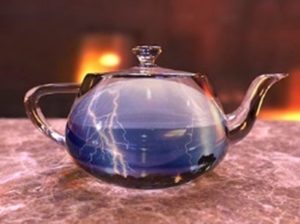Are you going on about something you feel is important but makes little difference to other people's lives? If so, someone might tell you that you're making a "tempest in a teapot," and you should calm down because it's not as bad as you think.
This post unpacks everything you need to know about the meaning, origin, and use of this expression.
Tempest in a Teapot Meaning
A "tempest in a teapot" is an expression meaning exaggerating or hyperbole involved with a situation. It's another way of saying that you're making a big deal out of nothing, and you need to relax. In the United States, people use the term "tempest in a teapot," while British people are more likely to use the phrase "a storm in a teacup."
You can use "tempest in a teapot" in social and professional settings to describe overreactions. For instance, if you're at the office and the boss starts reprimanding the staff for a minor problem, they make a tempest in a teapot about something unimportant.
If you're at home and watching the news, your partner might say, "They are making a tempest in a teapot," in reference to the news anchor overblowing the importance of a news story. Regardless of the setting, you'll use the expression to tell people that they are making something out of nothing.
Tempest in a Teapot Example Usage
"The Omicron variant shows that the disease is milder. Scientists are making a tempest in a teapot with their speculation, and they should look at the data, not make assumptions."
"Sheila says that the world is going to end after the Federal Reserve tightens the monetary policy. I think she's making a tempest in a teapot if you ask me."
"John thinks that the entire engine is blown, but I think he's making a tempest in a teapot. I think it's just blown a fuse."


Tempest in a Teapot Origin
The origin of "tempest in a teapot" extends back to the writings of Cicero in 52 B.C.E. The essays use an iteration of the phrase to stir the billows in a ladle. Much later in 1678, the Duke of Ormand would write a letter where he used the expression, "storm in a cream bowl."
The phrase would appear in its modern format in the 1800s, appearing in works from Scottish authors. The term would appear as "tempest in a teapot" or its more common current format, "storm in a teacup" at the time.
Today, it's more common for people to say "a storm in a teacup" as "tempest" is somewhat archaic and doesn't feature much in everyday conversation.
Phrases Similar to Tempest in a Teapot
- Strom in a teacup.
- To make a big deal out of nothing.
- To overreact to news or events.
Phrases Opposite to Tempest in a Teapot
- A serious situation.
- A problematic scenario.
What is the Correct Saying?
- Tempest in a teapot.
Ways People May Say Tempest in a Teapot Incorrectly
Some people may use the phrase to describe tea or teapots. The teapot, in this case, could be a micro or macro situation, not a teapot in the literal sense of the word. Using the phrase to describe a mild overreaction is also the incorrect use of the phrase.
Acceptable Ways to Phrase Tempest in a Teapot
You can use "tempest in a teapot" when you're trying to tell someone that they are overreacting to current events. For instance, if someone is talking about how the economy will sink because of failed policies, but there is no immediate signs or expectations of the outcome, they would be making a tempest in a teapot over nothing.